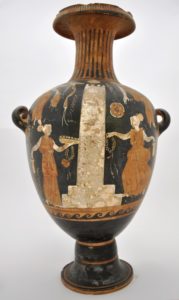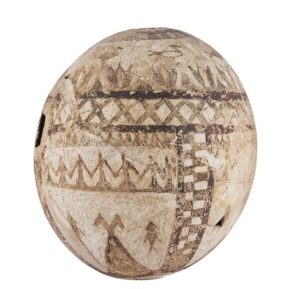Eggs… happy Easter!
Let’s talk about eggs to wish everyone a happy Easter!
The red-figure bell hydria by the painter of C.A (Cumae A), 4th century B.C., was purchased by the University of Pavia’s Museum of Archaeology in 1940 on the initiative of Professor Carlo Albizzati, on the Roman antiquities market. The hydria, probably destined to be part of funerary equipment, is perfectly preserved because was entombed for centuries. Unfortunately, we do not know where it was discovered. The vase, commonly used to hold water or oil, is decorated on the body with a large funerary stele that displays the offering of two eggs and two pomegranates. Around it are two women represented on either side in the two registers (four elements in total): those seated above and those standing below. The women all carry offerings to the grave: a basket full of foliage, wreaths and containers, including a tray full of eggs. The ancient thought that the dead needed food for their otherworldly banquet: as we still offer flowers, likewise, together with them, in antiquity people used to take food to tombs. They also had the custom to dine on them, perpetuating the memory of the beloved who had passed away. This tradition still survives today, for example in Calabria and Mexico.
Let’s add a curiosity: in the ancient Etruscan tombs, ostrich eggs have been found. These were decorated, painted or treated with specific acids to create a fretwork or bas-relief: they were luxury items imported from Africa that were pleasing to see but also had a deep symbolic meaning.
Even in ancient times, eggs always represented fertility and, therefore, wealth, as well as life and rebirth after death.
Thus, our chocolate eggs have very ancient roots…
The photos show the hydria from the Archaeological Museum of the University of Pavia, a painted Etruscan ostrich egg from the National Archaeological Museum of Tarquinia and an ostrich egg decorated with small holes and stars, from South Africa, where this tradition continues.



